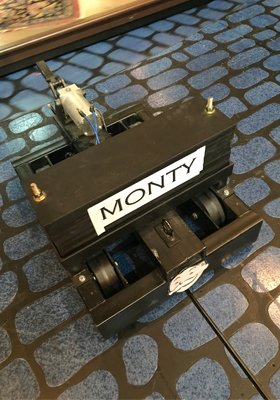The Vivian Beaumont stage has hosted many thrilling stage effects during its recent musical-theater productions: the orchestra reveal at the end of the overture in South Pacific, for example, or the ship hoving into view in The King and I. To these we can add the dramatic movement, from far up- to down-stage, of the Higgins Unit in the current staging of My Fair Lady.
The unit, which is 26 feet tall and has a diameter on its turntable of 38 feet, contains primarily the study-lab of Professor Henry Higgins, as well as other areas of his house at Number 27A Wimpole Street, London.
I asked Paul Smithyman, LCT’s production manager, to explain some of the machinery behind magic. “In simplest terms,” he said, “the unit consists of a track, a turntable, and a pneumatic moving piece. There is a big wagon with wheels underneath which is pushed along by a great big winch in the upper right corner of the stage. It pushes the wagon down until it’s all the way on the turntable. At that point, a new piece of technology comes into play.”
For no specific reason, that piece has been affectionately dubbed Monty. Monty is a small unit of compressed air that runs to a steel finger. Smithyman explained: “Monty was crucial to solving the central problem of the unit: it’s easy enough to push something down, but to pull it back up you have to grab it.”
When the Higgins Unit is in place downstage it is on the turntable, which is doing all the work. To take it away, Smithyman said, “Monty engages with the unit. He’s got a pneumatic piston that activates the down and the up. He grabs onto the steel rim of the truck, and pulls it away along the same track it came in on. ” Monty is, I remarked and Smithyman agreed, a Little Engine That Could.
Like any piece of scenery, the Higgins Unit does not operate in a vacuum. It must function in concert with the movement of actors and with the demands of the music. Smithyman provided an example. “The trickiest part of the Higgins Unit coming down takes places after the Ball scene. We have to clear out the previous set, and all the drops had to be out of the way before the unit could move.” And the unit, for all its wizardry, doesn’t zip along at warp speed. “It takes 28 seconds,” Smithyman said, “for the unit to go fully from upstage to downstage. That’s quite a long time for a transition.”
Did Smithyman ever worry, during the design and tech-rehearsal stages of My Fair Lady, that the challenges raised by the Higgins Unit would be insurmountable? “With a project like this,” he replied, “there are always moments when you wonder just how you’re going to solve the problem. But we worked out Higgins and Monty, just like we always work out problems in the end. That’s our job.”
Brendan Lemon is the editor of lemonwade.com
